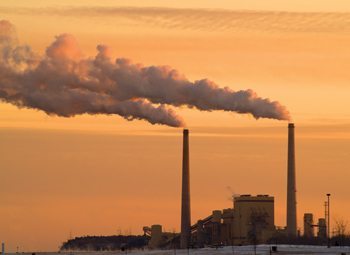A set of guidelines the U.S. Environmental Protection Agency has put forth under its Clean Power Plan has ignited debate about the best course of action for Wisconsin and its energy portfolio – one that historically has relied heavily on coal.

The final Clean Power Plan, headed by the Obama administration and announced in August, aims to cut carbon dioxide emissions by 32 percent from 2005 levels by the year 2030. Targets under the federal plan differ among states, as energy usage and resources vary among states. Under the plan, Wisconsin must decrease emissions by 34 percent.
In curbing carbon pollution generated by power plants, the Clean Power Plan is determined to weaken the effects of climate change and promote public health.
The Obama administration estimates that the plan could lead to 90,000 fewer asthma attacks in children and prevent up to 3,600 premature deaths.
Wisconsin critics of the Clean Power Plan worry about its financial consequences, particularly for state manufacturers.
“The punchline for Wisconsin under the new standards is they would essentially force or likely force the closure of most of our baseload coal plants,” said Steve Baas, vice president, governmental affairs, for the Metropolitan Milwaukee Association of Commerce. “And that is a huge hit to Wisconsin’s economy.”
To comply with the EPA, the state would have to spend billions of dollars retiring old coal plants and constructing new plants – and almost by definition, more expensive plants, according to Baas.

Those costs would be shouldered by ratepayers and predominantly manufacturers in Wisconsin, Baas said.
And by taking coal – the most cost-effective fuel source over the long run – out of the mix, the cost of Wisconsin’s energy portfolio would ramp up, according to Baas. Electric rates would skyrocket as more expensive fuel sources and technology would replace a more abundant and cheaper fuel source, he said.
If the state must suddenly rebuild its energy portfolio, “we very quickly become a noncompetitive state to do business in from a cost standpoint,” he said.
In March, Ellen Nowak, chairperson of the Wisconsin Public Service Commission, testified before the U.S. Senate’s Committee on Environment and Public Works with concerns about the Clean Power Plan.
According to Nowak, Wisconsin experts in utility rate modeling, economics, environmental regulation and engineering had estimated that the plan could, at minimum, cost Wisconsin ratepayers between $3.3 billion and $13.4 billion.
Keith Reopelle, senior policy director at Madison-based nonprofit Clean Wisconsin, however, said he is not convinced that estimate reveals much about the final cost of the plan. The cost estimate used some “completely unrealistic assumptions,” he said. For instance, the study assumed that Wisconsin would not be involved in trading credits for emission reductions with other states. The final plan rule encourages trading between states, and Wisconsin would be crazy to not take part, he said.

Reopelle said Clean Wisconsin is sensitive about Clean Power Plan costs but insists Wisconsin has many options to meet the target levels of reductions, including investing in bio digesters and energy efficiency. The EPA projects that ratepayers will see, on average, slightly lower energy bills by 2030, he said, as the agency assumes states will invest heavily in energy efficiency programs.
Clean Wisconsin sees the EPA’s regulations as “critical,” Reopelle said.
“We think that these guidelines are…a critical step for the United States to take toward establishing carbon pollution limits from the largest sources in the nation, which are coal fired power plants,” he said. “We view these carbon pollution limits as a very significant opportunity for the state of Wisconsin, not only because it’s important to limit the impacts of climate change because it affects public health and it affects natural resources and our built infrastructure, but we also think it’s a very significant opportunity for economic development in the state.”
For example, Wisconsin sends more than $12 billion outside the state to import fossil fuels annually, according to Reopelle.
To the extent that Wisconsin will shift to cleaner fuels and invest in renewable energy and energy efficiency, the state can keep more money inside state lines to propel the economy, he said.
Between energy renewable businesses and energy efficiency businesses, Wisconsin is home to nearly 1,000 businesses that will provide the systems and energy savings equipment needed for the state to comply with EPA standards, according to Reopelle.
“This is a tremendous growth opportunity for a whole lot of businesses here in Wisconsin,” he said.
Wisconsin has joined a band of states that have filed a lawsuit to stop EPA regulations, as states contend the agency has overstepped its authority.
The legal challenges within the lawsuit will have to be resolved before any regulations go into effect, Baas said, and the timetable remains unclear.

